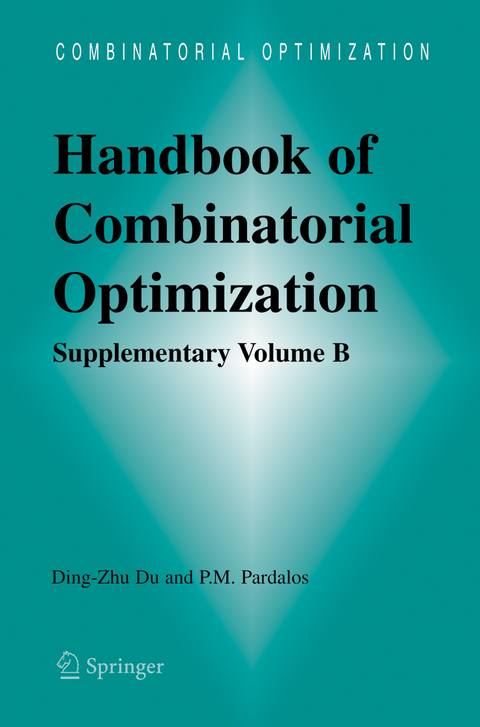
Handbook of Combinatorial Optimization
Supplement Volume B
Seiten
2004
Springer-Verlag New York Inc.
978-0-387-23829-6 (ISBN)
Springer-Verlag New York Inc.
978-0-387-23829-6 (ISBN)
Furthermore, combinatorial optimization problems occur in many diverse areas such as linear and integer programming, graph theory, artificial intelligence, and number theory. Many polynomial-time solvable combinatorial optimization problems are special cases of linear programming (e.g.
Combinatorial (or discrete) optimization is one of the most active fields in the interface of operations research, computer science, and applied ma- ematics. Combinatorial optimization problems arise in various applications, including communications network design, VLSI design, machine vision, a- line crew scheduling, corporate planning, computer-aided design and m- ufacturing, database query design, cellular telephone frequency assignment, constraint directed reasoning, and computational biology. Furthermore, combinatorial optimization problems occur in many diverse areas such as linear and integer programming, graph theory, artificial intelligence, and number theory. All these problems, when formulated mathematically as the minimization or maximization of a certain function defined on some domain, have a commonality of discreteness. Historically, combinatorial optimization starts with linear programming. Linear programming has an entire range of important applications including production planning and distribution, personnel assignment, finance, allo- tion of economic resources, circuit simulation, and control systems. Leonid Kantorovich and Tjalling Koopmans received the Nobel Prize (1975) for their work on the optimal allocation of resources. Two important discov- ies, the ellipsoid method (1979) and interior point approaches (1984) both provide polynomial time algorithms for linear programming. These al- rithms have had a profound effect in combinatorial optimization. Many polynomial-time solvable combinatorial optimization problems are special cases of linear programming (e.g. matching and maximum flow). In ad- tion, linear programming relaxations are often the basis for many appro- mation algorithms for solving NP-hard problems (e.g. dual heuristics).
Combinatorial (or discrete) optimization is one of the most active fields in the interface of operations research, computer science, and applied ma- ematics. Combinatorial optimization problems arise in various applications, including communications network design, VLSI design, machine vision, a- line crew scheduling, corporate planning, computer-aided design and m- ufacturing, database query design, cellular telephone frequency assignment, constraint directed reasoning, and computational biology. Furthermore, combinatorial optimization problems occur in many diverse areas such as linear and integer programming, graph theory, artificial intelligence, and number theory. All these problems, when formulated mathematically as the minimization or maximization of a certain function defined on some domain, have a commonality of discreteness. Historically, combinatorial optimization starts with linear programming. Linear programming has an entire range of important applications including production planning and distribution, personnel assignment, finance, allo- tion of economic resources, circuit simulation, and control systems. Leonid Kantorovich and Tjalling Koopmans received the Nobel Prize (1975) for their work on the optimal allocation of resources. Two important discov- ies, the ellipsoid method (1979) and interior point approaches (1984) both provide polynomial time algorithms for linear programming. These al- rithms have had a profound effect in combinatorial optimization. Many polynomial-time solvable combinatorial optimization problems are special cases of linear programming (e.g. matching and maximum flow). In ad- tion, linear programming relaxations are often the basis for many appro- mation algorithms for solving NP-hard problems (e.g. dual heuristics).
Data Correcting Algorithms in Combinatorial Optimization.- The Steiner Ratio of Banach-Minkowski spaces - A Survey.- Probabilistic Verification and Non-Approximability.- Steiner Trees in Industry.- Network-based Models and Algorithms in Data Mining and Knowledge Discovery.- The Generalized Assignment Problem and Extensions.- Optimal Rectangular Partitions.- Connected Dominating Set in Sensor Networks and MANETs.
| Mitarbeit |
Stellvertretende Herausgeber: Ding-Zhu Du, Panos M. Pardalos |
|---|---|
| Zusatzinfo | VIII, 394 p. |
| Verlagsort | New York, NY |
| Sprache | englisch |
| Maße | 155 x 235 mm |
| Themenwelt | Mathematik / Informatik ► Informatik ► Theorie / Studium |
| Mathematik / Informatik ► Mathematik ► Graphentheorie | |
| Wirtschaft ► Betriebswirtschaft / Management | |
| ISBN-10 | 0-387-23829-8 / 0387238298 |
| ISBN-13 | 978-0-387-23829-6 / 9780387238296 |
| Zustand | Neuware |
| Haben Sie eine Frage zum Produkt? |
Mehr entdecken
aus dem Bereich
aus dem Bereich
Grundlagen – Anwendungen – Perspektiven
Buch | Softcover (2022)
Springer Vieweg (Verlag)
CHF 48,95
was jeder über Informatik wissen sollte
Buch | Softcover (2024)
Springer Vieweg (Verlag)
CHF 53,15
Eine Einführung in die Systemtheorie
Buch | Softcover (2022)
UTB (Verlag)
CHF 34,95


